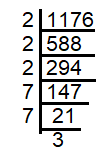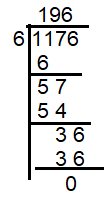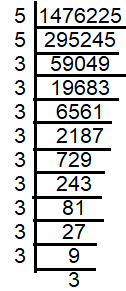FIND THE LEAST NUMBER WHEN DIVIDED BY TO MAKE PERFECT SQUARE
Problem 1 :
Find the least number by which 384 must be divided to make it a perfect square
Solution :
384 is not a perfect square. Accordingly the given information, we have to divide 384 should be divided by some integer inorder to make it as perfect square.

Grouping the terms as pairs
2 x 2 x 2 x 2 x 2 x 2 x 2 x 3
Here 2 x 3 is like extra, if we remove 6 it will become a perfect square.

Dividing 384 by 6, we get the quotient as 64 which is perfect square.
Problem 2 :
The least number by which 125 must be divided to make it a perfect square is
Solution :
125 is not a perfect square, to find by which number it should be divided to make it as perfect square, let us write 125 as product of prime factors.
125 = 5 x 5 x 5
Grouping as pairs, we get one extra 5.
So, 125 should be divided by 5 to make it as perfect square.
Problem 3 :
By which least number should 1176 be divided to make it a perfect square? find the perfect square number. also find the square root
Solution :
To find the least number that should be divided

1176 = 2 x 2 x 2 x 7 x 7 x 3
Here 2 and 3 are extra, by dividing 1176 by 6 we can get a number which is perfect square.

By dividing 1176 by 6, we get quotient as 196 which is perfect square.
√196 = √14 x 14
= 14
Square root of perfect square number is 14.
Problem 4 :
The area of a square field is 1476225 sqm. A motorist travels along its boundary at 36 km/hr. In how much time, will he return to the start point ?
Solution :
Area of square field = 1476225

√1476225 = √(52 x 310)
= 5 x 35
= 1215 m
Converting km/h to m/sec
36 km/hr = 36 x (5/18) m/sec
= 10 m/sec
One side length = 1215
Side length or length of the boundary line = 4(1215)
Speed = 10 m/sec
Time = distance / speed
= 4(1215) / 10
= 486 seconds
Converting into hours, we get
= 486/60
= 8.1 hours
8 hours and 10 minutes.
Problem 5 :
The least number by which 72 be divided to make it a perfect square is _____________.
Solution :
Expressing 72 as product of prime numbers, we get
72 = 2 x 2 x 2 x 3 x 3
Grouping them as pairs, we find one 2 as extra. By removing it,
= 2 x 2 x 3 x 3
= 36 (is a perfect square)
So, 72 should be divided by the least number 2 to convert it as perfect square.
Problem 6 :
By what smallest number should 216 be divided so that the quotient is a perfect square. Also find the square root of the quotient.
Solution :
Expressing 216 as product of prime factors, we get

216 = 2 x 2 x 2 x 3 x 3 x 3
By grouping as pairs, we get one 2 and one 3 as extra. So, 216 should be divided by 6 to make it as perfect square.
Dividing 216 by 6, we get 36 as quotient.
√36 = 6
Recent Articles
-
Finding Range of Values Inequality Problems
May 21, 24 08:51 PM
Finding Range of Values Inequality Problems -
Solving Two Step Inequality Word Problems
May 21, 24 08:51 AM
Solving Two Step Inequality Word Problems -
Exponential Function Context and Data Modeling
May 20, 24 10:45 PM
Exponential Function Context and Data Modeling